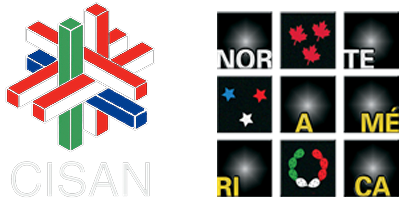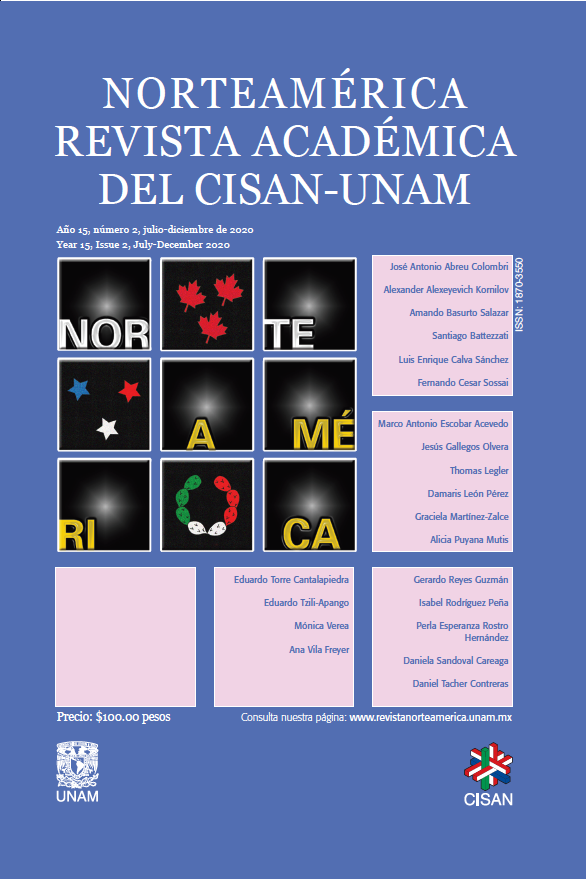Abstract
This article analyzes the importance of the Latino vote in the 2020 U.S. presidential elections, taking into account the growth of this sector of the population in the last 20 years and its com-position by national groups of origin. The author documents this sector’s demographic growth as a result of immigration, contrasted with its tendency to become U.S. citizens, thus affecting its electoral weight. Finally, he describes Latinos’ geographical location to consider this com-munity’s electoral weight in “battleground states” or “swing states,” where there is more com-petition for winning seats in the Electoral College.
References
Desipio, Louis
“Immigrant Organizing, Civic Outcomes: Civic Engagement, Political Activity, National Attachment, and Identity” en Latino Immigrant Communities. Center for the Study of Democracy, Paper #02–08, disponible en http://repositories.cdlib.org/csd/02–08, consultado el 19 de mayo de 2020.
Escobar, Cristina
“Dual Citizenship and Political Participation: Migrants in the Interplay of United States and Colombian Politics”,en Latino Studies, 2/1, pp. 45–69.
Galbraith, Quinn y Callister, Adam
“Why Would Hispanics Vote for Trump? Explaining the Controversy of the 2016 Election”, en: Hispanic Journal of Behavioral Sciences, Vol. 42(1), pp. 77–94.
Gómez-Quiñones, Juan
Chicano Politics: Realities and Promise, University of New Mexico Press, Albuquerque.
Gonzalez-Barrera Ana
junio ”Mexican Lawful Immigrants Among the Least Likely to Become U.S. Citizens”, disponible en: <https://www.pewresearch.org/hispanic/2017/06/29/mexican-lawful-immigrants-among-least-likely-to-become-u-s-citizens/> consultado el 19 de mayo de 2020.
Jensen, Lief, Cohen, Jeffrey, Toribio, Jaqueline Almeida, Dejong, Gordon, y Rodriquez, Leila
“Ethnic Identities, Language, Economic Outcomes among Dominicans in a New Destination”, en Social Science Quarterly, 87/1, pp. 1088–99.
Johnson, Martin, Stein, Robert, y Wrinkle, Robert
“Language Choice, Residential Stability, and Voting among Latino Americans”, en Social Science Quarterly, 84/2, pp. 412–24.
Jones-Correa, Michael
Between Two Nations: The Political Predicament of Latinos in New York City, Cornell University Press, Ithaca, New York.
Jones-Correa, Michael y Leal, David
“Becoming “Hispanic”: Secondary Pan-ethnic Identification among Latin American-Origin Populations in the United States”, en Hispanic Journal of Behavioral Sciences, 18/2, pp. 214–54.
Kumar, Anita y Ordoñez, Franco
septiembre, “Trump talks tough on immigration in Nevada but it could backfire”, disponible en: https://www.mcclatchydc.com/ news/politics-government/white-house/article218719245.html consultado el 29 de arbil de 2020.
Landale, Nnacy, y Oropesa, Ralph Salvador
“White, Black, or Puerto Rican? Racial Self-identification Among Mainland and Island Puerto Ricans#, en Social Forces, 81/1, pp. 231–54.
Marschall, Melissa
“Does the Shoe Fit? Testing Models of Participation for African-American and Latino Involvement in Local Politics”, en Urban Affairs Review, 37/2, pp. 227-48.
Mora, G. Cristina
Making Hispanics: How Activists, Bureaucrats, and Media Constructed a New American, University of Chicago Press, Chicago.
Pantoja, Adrian, Ramirez, Ricardo, y Segura, Gary
“Citizens by Choice, Voters by Necessity: Patterns in Political Mobilization by Naturalized Latinos”, en Political Research Quarterly, 54/4, pp. 729–50.
Pew Research Center
“U.S. Unauthorized Immigrant Total Dips to Lowest Level in a Decade”, disponible en: <https://www.pewresearch.org/hispanic/wp-content/uploads/sites/5/2019/03/Pew-Research-Center_2018-11-27_U-S-Unauthorized-Immigrants-Total-Dips_Updated-2019-06-25.pdf> consultado el 15 de mayo de 2020.
Pew Research Center
“Naturalized Citizens Make Up Record One-in-Ten U.S. Eligible Voters in 2020”, disponible en: <https://www.pewresearch.org/hispanic/2020/02/26/naturalized-citizens-make-up-record-one-in-ten-u-s-eligible-voters-in-2020/> consultado el 26 de abril de 2020.
Portes, Alejandro y Macleod, Dag
“What Shall I Call Myself? Hispanic Identity Formation in the Second Generation”, en Ethnic and Racial Studies 19/3, pp. 523–47.
Sanchez, Gabriel
“The Role of Group Consciousness in Political Participation among Latinos in the United States” en American Politics Research, 34, pp. 427–50.
Soergel, Andrew
febrero. “In 2020, 1 in 5 California Voters Will Be Foreign-Born. One-tenth of all eligible American voters, and one-fifth of all eligible Californians, will be foreign-born on Election Day 2020”, disponible en: <https://www.usnews.com/news/best-states/articles/2020-02-28/on-election-day-2020-1-in-5-california-voters-will-be-foreign-born> consultado el 8 de mayo de 2020.
Stokes, Atiya Kai
“Latino Group Consciousness and Political Participation”, en American Politics Research, 31, pp. 361–78.
Taylor, Paul, Lopez, Mark Hugo, Martínez, Jessica y Velasco, Gabriel
“When labels don´t fit: Hispanics and their views of identity”, disponible en: <https://www.pewhispanic.org/2012/04/04/when-labels-dont-fit-hispanics-and-their-views-of-identity/> consultado el 12 de mayo de 2020.
U.S. Census Bureau
“Census 2000 PHC-T-25. Migration by Race and Hispanic Origin for the Population 5 Years and Over for the United States, Regions, States, and Puerto Rico: 2000”, disponible en: <https://www2.census.gov/programs-surveys/decennial/2000/phc/phc-t-25/tab01.pdf?#> consultado el 12 de mayo de 2020.
U.S. Census Bureau
“2019 National and State Population Estimates”, disponible en: <https://www.census.gov/newsroom/press-kits/2019/national-state-estimates.html> consultado el 12 de mayo de 2020.
U.S. Census Bureau
“National Population Totals and Components of Change: 2010-2019”, disponible en: <https://www.census.gov/data/tables/time-series/demo/popest/2010s-national-total.html> consultado el 12 de mayo de 2020.

This work is licensed under a Creative Commons Attribution-NonCommercial-NoDerivatives 4.0 International License.
Copyright (c) 2020 Daniel Tacher Contreras



